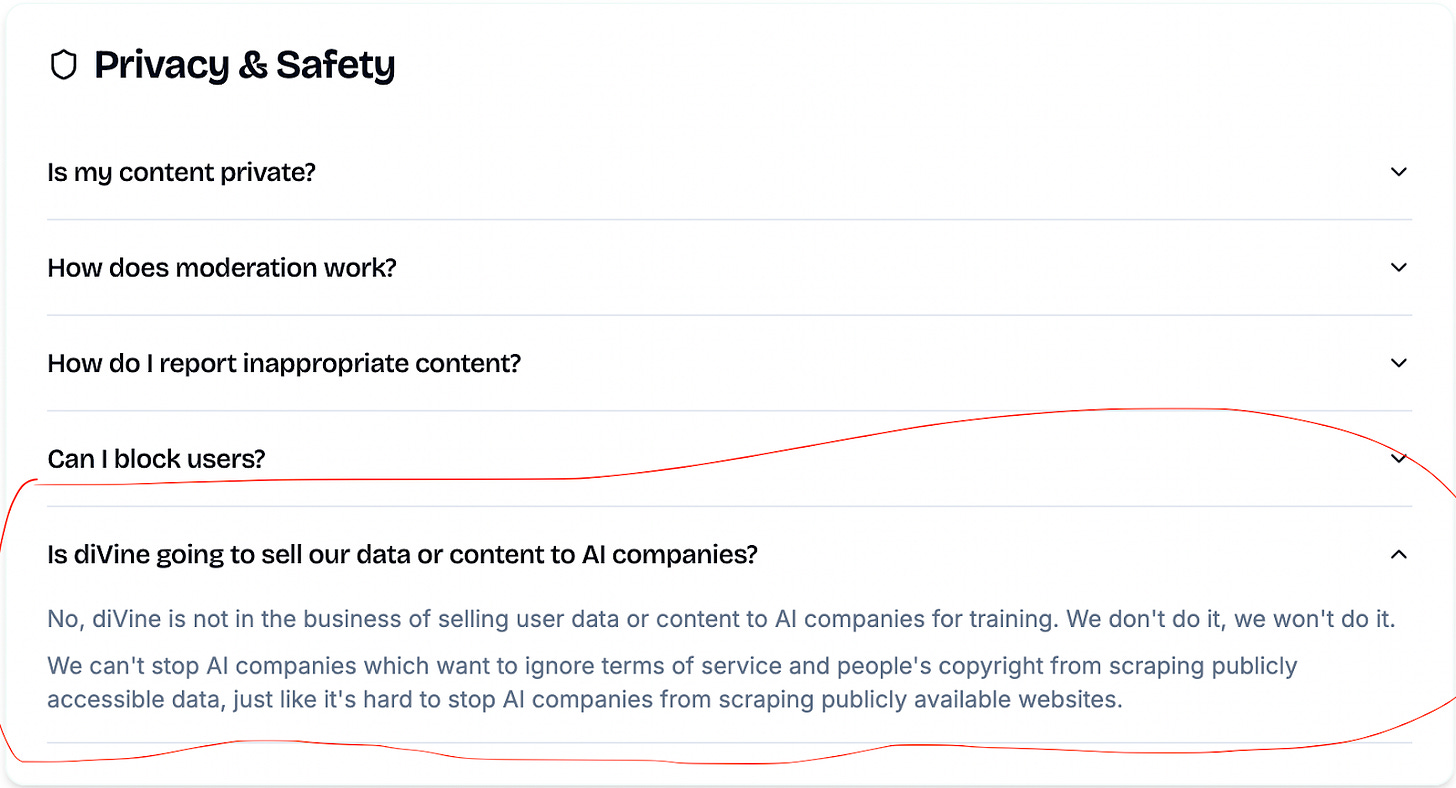They Brought Back Vine to Slay Sora
A new human-only video app is declaring war on AI slop
AI slop has gotten so bad they had to bring Vine out of retirement.
I drafted this newsletter post in a voice memo recorded from a balcony looking out at the South Bay in San Diego. Coronado Bridge in the distance, helicopters overhead, a cargo ship sliding past. I want you to feel the scene a bit because what we’re going to explore below is a mix of personal memory and a bigger technological moment we are living through.
(At the bottom of this post I’ve included that raw audio for paying subscribers, FYI).
diVine, a reboot of the old Vine, has launched in private beta. Six second looping videos. Tiny stories. Quick jokes. Little human flashes. Except this time it runs on a decentralized social protocol called Nostr, and its biggest selling point is not nostalgia. It’s the promise that this will be a place without AI generated video. A human-only zone. A no slop zone.
I think a lot of people are ready for that. I know I am.
My nostalgia for Vine is personal
Back in January 2014, my wife and I met for the first time. Fast Company was hosting a party for people on their Most Creative People in Business list. She was on the list. I was on the list.
The party had one of those little video stations set up. Back then, Vine was the hot thing. Everyone was making these micro videos for the booth.
But Elizabeth and I met, locked into conversation, and basically forgot there was a whole event happening around us. At some point, we stepped into that Vine booth and recorded a little six second moment about innovation. We barely cared about the prompt. We were distracted by each other. We went to dinner after. Then we started dating long distance. And that Vine is the very first recorded artifact of our relationship.
I never downloaded my Vine archive. At some point that video was frozen in time in Twitter’s servers and eventually disappeared with the platform. But diVine is promising to recover as many of those old Vines as possible. So I might get that little six second timestamp of our first night back.
The closest i can find is the Twitter post about the video:
If nostalgia is the bait, consider me hooked.
But diVine is doing something more interesting than simply reviving a vibe (re-vibing?). They are trying to revive control, trust and the belief that social media can still be a place for those of us who are not robots and don’t want to outsource all of our creative expression to robots.
What diVine is actually doing
Here are the key elements that matter:
One. It is built on Nostr, a decentralized open protocol.
Nostr lets you own your identity and your content separate from any single platform. So you are not locked inside a corporate server room. Think of it as a protocol for social content the way HTTP is a protocol for the web. It’s a more hardcore version of other decentralized protocols like ActivityPub (behind Mastodon) and the AT protocol (behind Bluesky).
Bonus: I ran a Perplexity Research query explaining the differences between all these and Meta in terms of censorship, data ownership, monetization and more. I’ll link to it below the paywall split at bottom.
Two. They explicitly ban AI generated video.
You cannot upload Sora videos. You cannot flood the feed with the infinite generative remix machine. It is a human-made environment on purpose. The founders know we are exhausted from guessing if the thing we are watching was made by a person, a prompt or a machine hallucination. diVine is saying no to all of that.
Three. It inherits the original Vine archive.
They have already restored tens of thousands of original Vine clips. They want to bring back a cultural moment, and give those creators an opportunity to claim their videos (or remove them).
Four. It is a bet on creator ownership.
By running on a decentralized protocol, creators own their content and their identity. This is the opposite of the locked in walled garden world we have lived in under Meta, TikTok and Twitter.
But decentralization has consequences
If you build a censorship-resistant system, there is nobody to complain to when someone misbehaves. According to the founders, the tradeoff is total user control. You can block, but you cannot go to central headquarters and ask them to remove someone. This is the logic of Nostr. Not corporate. Not centralized. Not moderated in a traditional top down way.
The human rights community sees the upside. The trust and safety community sees the risk. Both sides are correct.
The nostalgia play and its limits
There is always a market for nostalgia. Vinyl came back. Cassette tapes had a weird moment. I should have kept my college clothes because kids today are wearing the clothes I wore in the 90s. They would be worth a lot.
But there is a limit to nostalgia. We can’t build the future entirely by resurrecting the past. Six second videos might give us the feeling of simplicity, but the future is going to require formats and structures we have not invented yet. What about an app that’s the old game of telephone? We could see if the message fidelity held as you passed it on to someone else. Or, we could just use the “Phone” app on our devices to experience real-time audio communication with another human?! Anyway, giving people a space where they can expect human made moments again feels like a reset button we actually need.
Sometimes the solution to overwhelming technology is not to invent a new feature. It is to go back to something that made sense. The Jack Shephard line from Lost applies here. “Kate, we have to go back!” Not to stay there, but to remember what mattered.
The trust problem
One of the most interesting parts of this rollout has been people not trusting it. Because Jack Dorsey is involved with Nostr and helped fund this project, people immediately assumed this was a trap. The theory went like this: diVine is making a human-only video platform so they can gather clean, verified human content and sell it to AI companies as training data.
I get why people think that. It is 2025. After a decade of platform betrayals, it would be surprising if people did not assume the worst.
But after listening to the founders talk about their goals and the structure of Nostr itself, I do not think this is a plot to feed the AI machine. There are real technical limitations on how much they can prevent bad actors from scraping the videos, but that is a different issue.
The bigger point is that we are living through a low trust era. We question everything. We even question the systems that claim they are designed for us.
In a way, that skepticism is the healthiest part of the whole launch.
The official FAQ makes clear the company does not and will not sell data to AI companies for training. It also makes clear “we can’t stop AI companies which want to ignore terms of service and people’s copyright from scraping publicly accessible data.”
The safest is not to post in public. Long live group chats with message self-destruct sequences!
Questions I’m asking
How much do we really want a human-only social feed, and what would we sacrifice to maintain it?
Matt Klinman, friend of the show and former Onion colleague, joked perfectly about our need to have a bots-only internet and another one for people. I like the idea and clearly the team and diVine have been paying attention to our show ;)
Is banning AI generated content a long term stance or a temporary marketing line?
It’s great marketing. Here’s my VC-speak take on it. If just one percent of the people on social media who complain about AI slop signed up for diVine, they would be wildly successful. But what makes a social network work is partly being connected to people, the network part, at least in the classic mode of a social platform. And increasingly the other requirement is compelling content to keep you coming back. So the real test will be the quality of new videos uploaded to the service after we tire of Vine reruns.
Does decentralization improve the creator economy, or does it simply shift complexity onto the creator?
I love the idea of individual-level controls on my experience of technology, managing privacy settings, controls on distribution, monetization, and more. But I know the reality for most people, myself included, is we are not going to do that. Managing all those settings is exhausting and overwhelming. As a creator now, it’s a complete pain in the ass just to get my content up on various platforms. So diVine and others will need to solve for more than centralized platform ownership if they want to welcome large numbers of creators to their service. It will have to be simply and joyous to use.
What I want next
I want to see what a human-first social space looks like in the age of Sora. I want to see if six seconds can still make me laugh or feel something. I want to see if all of us are so tired of synthetic content that we run toward anything with a heartbeat.
Most of all, I want that Vine of Elizabeth and me. The very first artifact of our story. The little six second spark at the beginning of everything.
If diVine gives me that, it will already have achieved something real. If it gives us a glimpse of what social media after AI slop could look like, that is even better.
Let me know what you think. Should we try this place out or wait and see what kind of humans show up there first? What other services would you bring back, even with a twist?
💰 Bonus Materials
For those of you who have decided to give us money every month, thank you! We’re packaging two items exclusively for you:
The raw voice memo version of this newsletter in its draft form. Completely unfiltered Baratunde.
An AI-generated research report explaining the differences in decentralized social protocols and how they compare to the experience on Meta platforms.
Thanks to Associate Producer Layne Deyling Cherland for editorial and production support and to my executive assistant Mae Abellanosa.
Keep reading with a 7-day free trial
Subscribe to Life With Machines to keep reading this post and get 7 days of free access to the full post archives.





